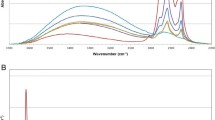Abstract
Extracts of Scandinavian birch (Betula pendula Roth) buds and internodes of varying twig diameters have been investigated for their inhibitory effect on ruminant digestibility in vitro. The predominant inhibitory effect was observed in extracts containing the phenol platyphylloside, 5-hydroxy-1,7-bis-(4-hydroxy-phenyl)-3-heptan-one-3-O-β-d-glucopyranoside. Isolation of the pure compound and incubation with rumen inocula showed that digestibility was negatively related to the concentration. Significant effect was measured below the concentration naturally occurring in birch (0.8% of dry matter). Another isolated compound, the closely related rhododendrin, 4-(4-hydroxyphenyl)-2-butanol-2-O-β-d-glucopyranoside, did not depress digestibility within the concentrations found in birch. An important phenol of buds, apigenin-4′,7-dimethylether, did not have any measurable effect on digestibility, while a nonphenolic fraction of bud extract had a slight inhibitory effect on digestibility. Implications for browsers feeding on birch are briefly discussed.
Similar content being viewed by others
References
Archangelski, K. 1901. “Rhododendrol” in Blättern v.Rhododendron chrysanthum.Chem. Zentralblatt II:594.
Biftu, T., andStevenson, R. 1978. Flavone and triterpenoid constituents ofElaegia utilis.J. Chem. Soc. Perkin Trans. 1:360–363.
Bryant, J.P. 1981a. The regulation of snowshoe hare feeding behaviour during winter by plant antiherbivore chemistry, pp. 720–731,in Proceedings, World Lagomorph Conference, Guelph, Canada, 1979.
Bryant, J.P. 1981b. Phytochemical deterrence of snowshoe hare browsing on adventitious shoots of four Alaskan trees.Science 213:889–890.
Bryant, J.P., andKuropat, P. 1980. Selection of winter forage by subartic browsing vertebrates. The role of plant chemistry.Annu. Rev. Ecol. Syst. 11:261–285.
Bryant, J.P., Wieland, G.D., Reichardt, P.B., Lewis, V.E., andMcCarthy, M.C. 1983. Pinosylvin methyl ether deters snowshoe hare feeding on green alder.Science 222:1023–1025.
Gates, R., andOrians, G.H. 1975. Successional status and the palatability of plants to generalized herbivores.Ecology 56:410–418.
Coley, P.D., Bryant, J.P., andChapin, F.S. 1985. Resource availability and plant antiherbivore defense.Science 230:895–899.
Danell, K.,Bergström, R., andDirke, K. 1987. Moose browsing on juvenile and adult birch (Betulapendula andB. pubescens): Test of a hypothesis on chemical defense. Proceedings, Union of Game Biologists, Czechoslovakia, in press.
den Braaver, E. andEriksson, S. 1967. Determination of energy in grass hay by in vitro methods.Lantbrukshoegsk. Ann. 35:751–765.
Feeny, P. 1975. Biochemical coevolution between plants and their insect herbivores. pp. 3–19,in L.H. Gilbert and P.H. Raven (eds.) Coevolution of Animals and Plants. Texas University Press, Austin.
Freeland, W.J., andJanzen, D.H. 1974. Strategies in herbivory by mammals: The role of plant secondary compounds.Am. Nat. 108:269–289.
Nomura, M., Tokoyorama, T., andKubota, T. 1981. Biarylheptanoids and other constituents from wood ofAlnus japonica.Phytochemistry 20:1097–1104.
Ohta, S., Koyama, M., Aoki, T., andSuga, T. 1985. Absolute configuration of platyphylloside and ((-)-centrolobol.Bull. Chem. Soc. Jpn. 58:2423–2424.
Palo, R.T. 1984. Distribution of birch (Betula spp.), willow (Salix spp.), and poplar (Populus spp.) secondary metabolites and their potential role as defence substances against herbivores.J. Chem. Ecol. 10:499–520.
Palo, R.T. 1985. Chemical defense in birch. Inhibition of digestibility in ruminants by phenolic extracts.Oecologia 68:10–14.
Palo, R.T., Pehrson, Å., andKnutsson, P.G. 1983. Can birch phenolics be of importance in the defense against vertebrate herbivores?Finn. Game Res. 41:76–80.
Palo, R.T., Sunnerheim, K., andTheander, O. 1985. Seasonal variation of phenols, crude protein and cell wall content of birch in relation to ruminant in vitro digestibility.Oecologia 65:314–318.
Pehrson, Å. 1980. Intake and utilization of winter food in the mountain hare (Lepus timidus). A laboratory investigation. Thesis. University of Stockholm, Department of Zoology.
Pehrson, Å. 1981. Winter food consumption and digestibility in caged mountain hares, pp. 732–742,in Proceedings, World Lagomorph Conference, Guelph, Canada, 1979.
Pullianen, E. 1972. Nutrition of the arctic hare (Lepus timidus) in northeastern Lapland.Ann. Zool. Fenn. 9:17–22.
Reichard, P.B., Bryant, J.P., Clausen, T.P., andWieland, G.D. 1984. Defence of winter dormant Alaskan paper birch against snowshoe hares.Oecologia 65:58–69.
Rhoades, D.F. 1979. Evolution of plant chemical defense against herbivores, pp. 3–54,in G.A. Rosenthal, and D.H. Janzen, (eds.). Herbivores, Their Interaction with Plant Secondary Metabolites. Academic Press, New York.
Risenhoover, K.L., Renecker, I.A., andMorgantini, L.E. 1985. Effects of secondary metabolites from balsam poplar and paper birch on cellulose digestion.J. Range Manage. 38:370–372.
Rosenthal, G.A., andJanzen, D.H. 1979. Herbivores, Their Interaction with Plant Secondary Metabolites. Academic Press, New York.
Salo, L.J. 1973. Chemical composition and caloric content of the autumn and winter diet ofTetrastes bonasia in northeastern Finnish Lapland.Ann. Zool. Fenn. 10:384–387.
Santamore, F.S., andVettel, H.E. 1978. The distribution of rhododendrin in birch species.Biochem. Syst. Ecol. 6:107–108.
Siegel, S. 1956. Nonparametric Statistics for the Behavioral Sciences. McGraw-Hill, Kogakusha Ltd., Tokyo.
Svendsen, G.E. 1980. Seasonal change in feeding patterns of beaver in southwestern Ohio.J. Wildl. Manage. 44:285–290.
Swain, T. 1977. Secondary compounds as protective agents.Anna. Rev. Plant Physiol. 28:479–501.
Swain, T. 1979. Phenolics in the environment.Recent Adv. Phytochem. 12:617–640.
Tahavanainen, J., Helle, T., Julkunen-Tiitto, R., andLavola, A. 1985. Phenolic compounds of willow bark as deterrents against feeding by mountain hare.Oecologia 65:319–323.
Theander, O., andWesterlund, E. 1986. Studies on dietary fiber. 3. Improved procedures for analysis of dietary fiber.J. Agric. Food Chem. 34:330–336.
Terasawa, M., Koga, T., Okuyama, H., andMiyake, M. 1973. Isolation of platyphyllonol, a new diarylheptanoid from green bark of shirakanba,Betula platyphylla Sukatch. var.japonica Ham.J. Jpn. Wood Res. Soc. 19:47–48.
Terasawa, M., Koga, T., Okuyama, H., andMiyake, M. 1984. Phenolic compounds in living tissue of woods III.Mokuzai Gakkaishi 30:391–403.
Wollenweber, E. 1975. Flavonoid-Muster in Knospen-Exkret der Betulaceen.Biochem. Syst. Ecol. 3:47–52.
Wollenweber, E., andEgger, K. 1971. Flavonoid-Aglykone in Knospen-Exkret vonBetula ermanii.Z. Pflanzenphysiol. 65:427–431.
Author information
Authors and Affiliations
Rights and permissions
About this article
Cite this article
Sunnerheim, K., Palo, R.T., Theander, O. et al. Chemical defense in birch. Platyphylloside: A phenol fromBetula pendula inhibiting digestibility. J Chem Ecol 14, 549–560 (1988). https://doi.org/10.1007/BF01013906
Received:
Accepted:
Issue Date:
DOI: https://doi.org/10.1007/BF01013906




